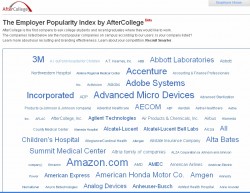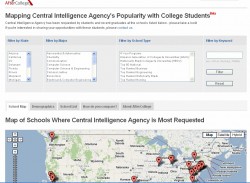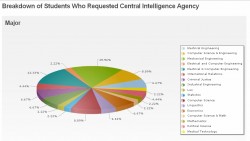 As might be expected from the pickup in overall hiring in the U.S., college seniors are looking at the best job hunting season in at least three years. And a new popularity monitor from AfterCollege is offering insights into where the students will be hunting.
As might be expected from the pickup in overall hiring in the U.S., college seniors are looking at the best job hunting season in at least three years. And a new popularity monitor from AfterCollege is offering insights into where the students will be hunting.
A survey out last September from the National Association of Colleges and Employers predicted employers would increase their 2011 hiring of graduating students by 13.5 percent.
So far, that prediction seems to be holding. Though down seasonally from November, December’s monthly NACE Index, which tracks hiring intent and recruiting activity, was solidly on the positive side. The Index, based on a survey of NACE’s 111 member companies, was substantially above where it was a year before. For the December survey, 46.5 percent of the respondents said they expected to do more college hiring in 2011 than in 2010.
Those numbers track well with the September prediction that had 47.7 percent of the NACE respondents expecting to do more college hiring.
Where will companies be recruiting? Most probably at the schools where they always have. IT firms will go to MIT, Stanford, and Virginia Tech. Investment banks and major accounting firms will head off to Harvard, Carnegie Mellon, Wharton, and Booth.
While there are good reasons for the “same old, same old,” AfterCollege has a fun, new beta tool that corporate college recruiters might just want to consider.
The Employer Popularity Index from AfterCollege is a real-time graphical display of the interest college students have in working at particular companies. It’s so new (it launched just as campuses were clearing for winter break) that even finding it on the site is no easy task.
 But it’s worth the effort if for no other reason than it’s fun. (What effort? Just click the link.) I’ve been playing with it for a couple days now and discovered, to my surprise, that the Central Intelligence Agency is hot. It ranks 18th on the list of the top-25 most-requested employers.
But it’s worth the effort if for no other reason than it’s fun. (What effort? Just click the link.) I’ve been playing with it for a couple days now and discovered, to my surprise, that the Central Intelligence Agency is hot. It ranks 18th on the list of the top-25 most-requested employers.
Google is first on the list, which I could have guessed. And CIA interest is behind Microsoft, GE, and Intel among others. But the Agency beats out Oracle, NASA, and Yahoo!.
“Right now it is cool and interesting,” says AfterCollege CEO Robert Angulo, of the Employer Popularity Index (EPI). But as students return from vacation and seniors resume their post-graduation job search, the 25,000 student participants will swell. By the end of the semester, Angulo expects more than 100,000 students to register their employment interest.
As participation grows, so will the usefulness of the Index. (Can anyone suggest a catchier name?)
Dig through all the data for a while and you discover just who it is that’s  looking at particular companies. I wouldn’t have thought this before now, but computer science and engineering students are the ones most jonesing for the CIA. And interest in working for “The Company” clearly grows the closer a student gets to graduation.
looking at particular companies. I wouldn’t have thought this before now, but computer science and engineering students are the ones most jonesing for the CIA. And interest in working for “The Company” clearly grows the closer a student gets to graduation.
Freshman, sophomores, and juniors participate in the EPI, along with seniors, new grads, and recent alums. Charts show the percentage of each, which should be a great help to recruiters in planning a campaign and in measuring how interest changes as students mature.
Angulo and I talked about just what it is that the EPI measures. Brand power is undoubtedly an influencer. However, Angulo says it’s not as much a driver as it might seem. The data to power the charts and the Index come from the three employer choices students make when they register.
So while a student might pick Google as one of their three top employers of interest based on brand, AfterCollege uses that to send the student Google’s job openings. Now at some point, an English Lit major discovering Google doesn’t have a big demand for them, will change the employer preferences.
Juniors and seniors in particular, as they get serious about the job hunt, become more realistic in targeting companies.
“Branding has some influence,” Angulo acknowledged, “but students get a lot more realistic when they really start looking for a job.” The EPI, he says, “measure the desire of a student.”
There are probably as many ways to make use of the data here as there are recruiters. The numbers are too small yet to use the EPI to plan recruiting trips, but spotting pockets of interest is easy enough for the listed companies. That might suggest developing a social media outreach at a particular school, enlisting employee-alums to promote the company, or (as AfterCollege no doubt hopes) posting jobs there.
Over time, a company can also see how it trends in popularity with students. That can let a recruiter gauge the success of the marketing efforts.
This is only a sampler of how the EPI can be used in campus recruiting. You’ll no doubt come up with plenty others. Just make sure to look at the sample size, something Angulo and AfterCollege conveniently include in the charts, and data tags. As student participation grows — a marketing push is coming, as are some additional features — the usefulness will also grow.
On the other hand, I’m still marveling that even one student at Berkeley wants to work for the CIA. The proverbial chink in the armor or a clandestine opp?